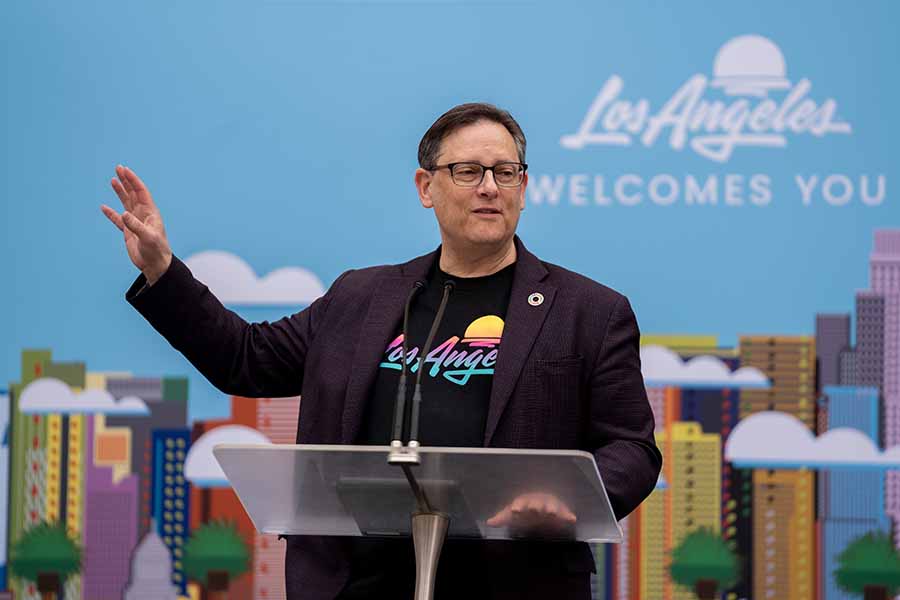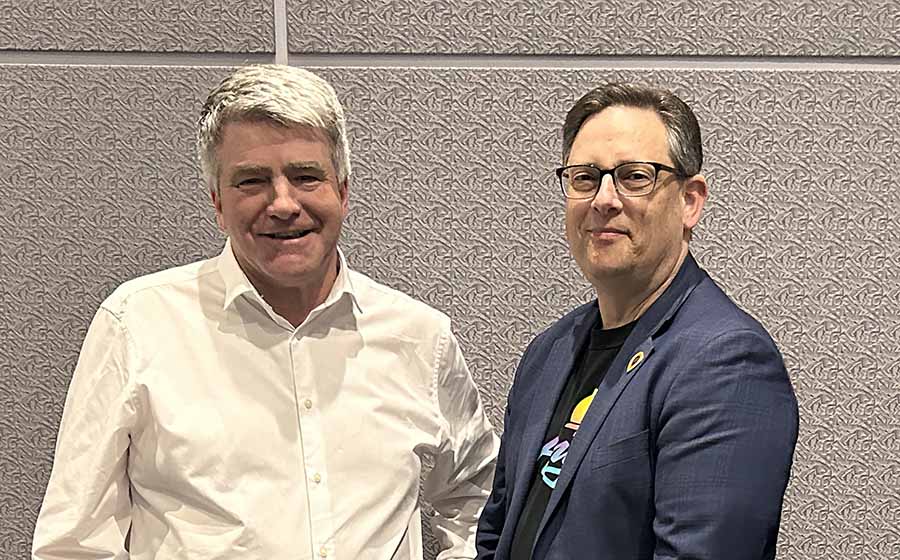
What happens next in LA? The benefits that accrue from being host city of IPW, the United States tourism showcase, are famously difficult to measure. San Antonio 2023 is expected to drive an incremental $614m over three years.
Los Angeles is different. It is already back to 97pc of pre-pandemic levels, 49.1m visitors in 2023, and international travel back to 79pc of pre-pandemic.
Tourism revenue is 6.9;pc ahead of pre pandemic at USD40.4bn, supporting 530,000 tourism-related jobs for locals. Hotel demand saw 30.2m room-nights sold with a 71.7pc occupancy rate and an average daily rate of USD198, reducing tax burden by USD3.2bn, saving each household USD965.
Tourism LA director Adam Burke presided over events with evangelical zeal, for his city and its oft-overlooked downtown. We made the point that one of the things covering tourism in LA is that LA seems to get left to the side by the districts. They have very powerful brands in Hollywood and Santa Monica, and places like that, whereas it is hard for a visitor to define LA and picture LA.
“That’s something you’ve addressed” says Mr Burke, “something I’ve seen change actually in the last, I mean, I think there are two ways of looking at it. First thing is, and by the way, you’re welcome to record if you’d like. Yeah, I do that. Is the experience because from a consumer’s perspective, I actually suspect if you were to stop 100 Angelenos on the street and ask, “Is Marina Del Rey part of the city of Los Angeles?” They would all say yes.
So from our perspective, it’s about the broader region because Marina del Rey, Beverly Hills, West Hollywood, Pasadena, and Santa Monica are all part of the LA experience. So we actually work very closely with all of them. They’re part of the extended family. The second thing is, why swim upstream? You know, already visitors perceive it as the broader LA region. So we want to promote everything there is to do across the region. Now, I will say, this is what I struggled with when I first moved here, and this is why I so appreciate the direction we’ve taken, which is you can’t think of LA as a city; you really have to think of it as six distinct regions. And that’s the first way to ground it.
“A good example is when we do focus groups and meet with the trade internationally. What I’ll say is we did a focus group in Germany last year and I said, “Okay, if you had 48 hours, would you try to do Dusseldorf, Munich, and Frankfurt in 48 hours?” And they look at you like you’ve lost your head. And so, now you understand Los Angeles. So don’t try to do all of LA in one bite, because that’s actually what I love about it. You can come here twice a year and have a totally different experience every time for the rest of your life.
“The six regions of Los Angeles are Downtown, which has a very different flavour than Hollywood and the Valley. You’ve got the Mid-Cities area where you’ve got the Academy Museum and you’ve got the Beach Cities area, the Westside, and South LA. So once you break it down into those six regions, then that’s a great starting point because you have a much better understanding of how to make the most of your time in LA.”
An innovation in Los Angeles is that bricks and mortar visitor centres are being replaced by on street tourism ambassadors: we used to have brick-and-mortar visitor information centers. “What we realized coming out of the pandemic is you need to be more agile, more mobile than that. So, we’ve actually been working with all of our local business improvement districts because they have uniformed ambassadors who are very visible presence on the street, but also they understand the neighborhood. So, they’re a great source of information. We decided not to reopen our brick-and-mortar centres, and instead, we’ve been supplementing the budgets of the business improvement districts to get more ambassadors on the streets and actually give them additional training on the broader destination. So, let’s say you’re in downtown Los Angeles and you want to understand how to get to Venice Beach. we’re providing that training so that those ambassadors can do just that.”
“I always think, if I had a friend coming to Los Angeles for the first time, how would I want them to make the most of their time?
“And my answer, believe it or not, is car-free. Because if you’re going to try and spend all your time driving to all these places, I want you to spend most of your time exploring our neighbourhoods, exploring everything there is to do. The second thing we do is, after those six regions, we then talk about what do you have an affinity for? Do you love arts and culture? Do you love culinary experiences? Do you like sports and entertainment? A
“So, you can look at it and you can say, “Okay, now I understand these six regions, but I’m a family traveling with young kids.” Great stay, for example, at The Garland, which is a wonderful hotel. It’s been rated the best family hotel in LA. It’s literally five minutes from both Universal Studios Hollywood and Warner Brothers Studio Tour. You’ll have a wonderful experience on the property. You’re five minutes away from the parks, and you won’t have to drive everywhere. So for the days you’re going to the park, stay there. If someone else says, One of my favourite areas is the Arts District, which is just five minutes from downtown. “
“If you’re someone like me who loves architecture and street art because it’s so unique, with all the street art from people like Shepard Fairey and Mister Cartoon, amazing architecture, great restaurants, stay at a boutique hotel in the Arts District for three or four days. You can walk everywhere; you’ll never need a car. No matter where you’re going, that’s the other part of it – what do you want to do?
“Our itineraries are themed around culinary, sports, etc., but also LA on a budget, luxury LA. There’s been a big trend towards female solo travel, so what we’re trying to do is just make it easier for people to understand the destination. And that includes Santa Monica, Beverly Hills, etc. That’s part of the experience. Interesting you say car-free. The public transport when you first arrived in Los Angeles was very minimal.”
“Growing up in Chicago, somewhere that has terrific mass transit, I think any tier one destination, whether you’re in the UK or in Asia, you expect there to be very workable mass transit.
“Stephanie Wiggins is the CEO of LA Metro, and she and her team have done a phenomenal job of expanding their route map. They’ve even done things like adjusting their routes and timing based on major events coming to Los Angeles.
“For example, when Taylor Swift came, they actually extended their hours and added additional lines so that people going to and from the concert could easily get there from all over LA. They’ve been great partners, and yeah, the amount of mass transit now is exponentially greater than it was. People used to say you couldn’t go near the city without a car. It’s the old Missing Persons song “Nobody Walks in LA.” Actually people do walk in LA, and I think it’s the best way of experiencing it because the other trend that we’re seeing, especially among younger travellers, is that they obviously want to go to the marquee attractions. So they want to go to SoFi Stadium, Super Nintendo World, or the Academy Museum, but they also want the authentic experience. They really want to see what’s unique about LA.
“Given that this idea of doing a deep dive in a neighbourhood, that’s when you really get a feel for the neighbourhood, all these incredible cultures and traditions. And honestly, that’s what I love about LA more than anything else. Yes, we can talk about all the amazing new openings, but the thing I’ve really come to appreciate about LA is Angelinos come from 140 different countries, and there are more than 220 different languages spoken here.”
“That infuses every aspect of life in LA, from our culinary scene to the arts. It really is this place where diversity is celebrated, and I think that’s part of the reason why it’s such a popular international destination. No matter where you come from, you’re going to find a huge community here, and you’ll not just feel welcomed and embraced by the community. it’s not so much that people come here and just want to go to Hollywood, but it’s that aspiration of coming because of Hollywood, because of film and cinema that then becomes the entryway to exploring everything else. Los Angeles now has more museums and performing arts venues than any other destination in the country. We have 11 professional sports teams, the most in the country. We now have over 200 Michelin-recogniaed restaurants and 25 Michelin stars, plus amazing street food. So, in every regard, Hollywood might be one of the iconic things that gets people to LA, but then they want to get out and explore everything else.”

